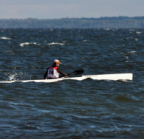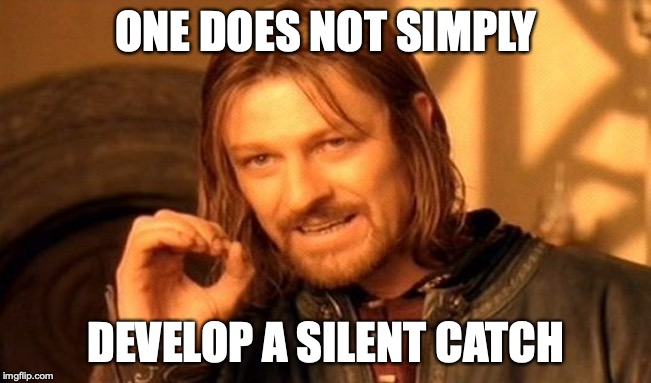How crucial is silent blade entry?
One thing I can tell pretty easily is how much noise / splash I make on the blade entry / catch phase of the stroke. There's often a noticeable, percussive "shbloop" with each blade entry as water slaps into the concavity of the wing blade. But sometimes if I'm really careful and twist the paddle a little more in the air and "spear" a little more deliberately I can sneak the blade in without hearing and feeling the "shbloop".
I guess my question is, how bad is "shblooping" and is it worth forcing myself to do shbloopless paddling?
Stellar SEI 1g
Please Log in or Create an account to join the conversation.
- zachhandler
-

- Offline
- Platinum Member
- Posts: 799
- Thank you received: 202
Current Skis: Nelo Vanquish AIR, Epic V10g4, NK 670 double, NK exrcize, Carbonology Feather, Think Jet, Knysna Sonic X
Former Skis: Epic v10g3, Kai Waa Vega, Epic V12 g2, Epic V12 g1, Epic v10 double, Nelo 550 g2, Fenn Elite S, Custom Kayaks Synergy
Please Log in or Create an account to join the conversation.
- SurfskiEstonia
-

- Offline
- Premium Member
- Posts: 122
- Thank you received: 15
Can You describe Your forward stroke technique as rules that You'd like to follow.
Mine are here (high elbow technique):1. sit up leaning slightly forward;2. the upper hand is on the level between nose and chin and it doesn't cross the spine line to the other side;3. the upper hand doesn't squeeze the paddle shaft (hand grip almost open), neither does the lower hand, which gives the opportunity for the blade to find it's optimal (designed) way in the water;4. the stroke should be short - entry as far as possible without the splash with a straight arm/ fixed elbow, then exit already before reaching the hip level;5. the paddle shaft should be as vertical as the boat width allows.I think it will be much easier to comment on the reasons knowing Yours, at least of me:)
Current: Carbonology Boost double, Jantex Gamma Mid
Previous: Nelo Ocean Ski L, Jantex Gamma Rio Large Minus
Please Log in or Create an account to join the conversation.
- David Grainger
- Offline
- Senior Member
- Posts: 68
- Thank you received: 20
Please Log in or Create an account to join the conversation.
Cavitation causes the blade to lose its "lock" on the water, so you end up pulling the blade past the ski, rather than the ski past the blade.
Please Log in or Create an account to join the conversation.
- David Grainger
- Offline
- Senior Member
- Posts: 68
- Thank you received: 20
Please Log in or Create an account to join the conversation.
- Henning DK
- Offline
- Senior Member
- Posts: 78
- Thank you received: 25
But the catch is: With correct silent entry, the others come naturally - without it, they don't.
Please Log in or Create an account to join the conversation.
- David Grainger
- Offline
- Senior Member
- Posts: 68
- Thank you received: 20
Henning DK wrote: You can discuss what is most important: silent entry, leg drive and rotation, early exit,...
But the catch is: With correct silent entry, the others come naturally - without it, they don't.
It took me 206 words to say what you said more clearly in 31!
So, for advice in practicing, I'd recommend
1. Develop silent catch on mirror flat water, at slow cadence
2. Fix it into muscle memory so it happens automatically without thinking about it
3. Gradually increase cadence until you can sprint without losing it
Then take it into waves, and repeat all 3 steps
I still have to think about it when I'm sprinting to catch waves.
Please Log in or Create an account to join the conversation.
- SurfskiEstonia
-

- Offline
- Premium Member
- Posts: 122
- Thank you received: 15
(it's easy to say silent catch is important and very difficult to achieve it in the correct form)
My suggestion would be to try to keep the upper hand with open fingers and the lower hand as loose as possible. Never squeezing the paddle shaft with either hand will set the stroke to its most natural way.
Current: Carbonology Boost double, Jantex Gamma Mid
Previous: Nelo Ocean Ski L, Jantex Gamma Rio Large Minus
Attachments:
Please Log in or Create an account to join the conversation.
Due to this thread I went sans the ear buds the other day to "listen" to my stroke. I realised very quickly there was a lot of sloshing when the blade entered the water.
It took me a while to get it to quiet down. What I noticed was I needed to lower my cadence but my speed did not really drop. I spent the next hour really focussing on a silent or quiet catch. It is not easy and clearly I have some bad habits that are ingrained in my stroke.
I think for the next while I will need to paddle without my ear buds and listen to my stroke and see if I am able to improve my stroke mechanics.
Thanks for brining this up.
Please Log in or Create an account to join the conversation.
My experience as I continue to work on it, is that it's incredibly, frustratingly difficult to do consistently. It's much easier on my standup paddleboard with its flat, single-bladed paddle- I just remember to spear forward and down before pulling and it's perfectly quiet and it all makes sense and feels right.
I think part of my difficulty is getting the shaft twist / side-to-side angle of the blade correct during the entry. With a sup paddle, the flat face of the blade is always perpendicular to the longitudinal axis of the board, at least until the exit. But with the wing blade kayak paddle (I have a Braca XI 705) I wouldn't know perpendicular even if I was looking straight at it because of how curved the blade is. And while I am trying to get the shaft as vertical as the width of the boat will allow, there is some angle... and there's kind of a dilemma of if I should be purely spearing in with no change in shaft angle at the entry, or if I there can be a bit of slicing in from the outside at the entry (knifing towards the boat with trailing edge of the wing as the leading edge of the knife) or a bit of slicing out from the inside (knifing away from the boat with the fat leading edge of the wing as the front of the knife). Obviously during the main phase of the stroke the leading edge of the wing knifes away from the boat.
It's also complicated by the fact that the boat is moving. Like, there has to be some pull as the blade goes in just to keep up with the water. So I feel like I not only have to get the general silent catch right, but I have to be able to change gears and timing to stay silent as the boat speed and cadence pick up, contributing to my "this is impossible!" feeling.
I'd like to see a video (with audio) of someone getting the silent catch down right.
Stellar SEI 1g
Please Log in or Create an account to join the conversation.
Please Log in or Create an account to join the conversation.
- SurfskiEstonia
-

- Offline
- Premium Member
- Posts: 122
- Thank you received: 15
I already repeated this twice, but gonna say it again in a form of a question:
Have You tried paddling with a really loose grip? Meaning that You literally open the upper hand (fingers don't touch the paddle shaft) and the lower (blade-in-water) hand has maybe 2-3 fingers max on the blade shaft (for me: definitely the middle finger and index/weddingring fingers lightly). With the lower hand the blade shaft is being kept there for the pull to be possible - the fingers are not gripping the paddle shaft into the palm, just holding enough to pull.
Why I stress this so much is I feel that is the easiest way for a self-taught paddler to understand the correct technique. I have had many lessons with several K1 coaches. Also discussed technique with young K1 athletes, which actually gave me more insight into the forward stroke technique than those lessons. On really stormy days I have to grip pretty hard on the paddle shaft, but when the conditions are milder and especially on longer paddling outings (15-25km) the loose grip is the key for speed and energy conservation.
So, D0uglass, how would You comment on this - have You tried this and what are Your thoughts?
Current: Carbonology Boost double, Jantex Gamma Mid
Previous: Nelo Ocean Ski L, Jantex Gamma Rio Large Minus
Please Log in or Create an account to join the conversation.
- Henning DK
- Offline
- Senior Member
- Posts: 78
- Thank you received: 25
To me, it makes a lot of sense to pay attention, that the entry phase (catch) and the power phase are SEPARATE phases. The entry must be completed before any power is applied to the stroke, and the moment you apply power to your stroke, the entry is finished. So finish the catch properly, and then you can apply full power straight away.
If you apply power before finishing the entry, both phases wiill be disturbed.
One way to practise this it to first paddle without power (free-wheeling) and getting the entry in place, and then gradually apply more force to the power phase taking care that this does not disturb the entry.
- And remember, power does not come from your arms, they only deliver. You must feel the power coming from your body rotation, all the way down to "standing" on your foot
Please Log in or Create an account to join the conversation.
Practice Oscars one handed catch drill, that will prevent you doing all the work with the same hand
Please Log in or Create an account to join the conversation.
- SpaceSputnik
- Offline
- Platinum Member
- Posts: 526
- Thank you received: 42
Please Log in or Create an account to join the conversation.
Latest Forum Topics
-
- Paddling with rotator cuff injury
- 5 hours 37 minutes ago
-
- McGregor Rhythm questions
- 2 days 22 hours ago


